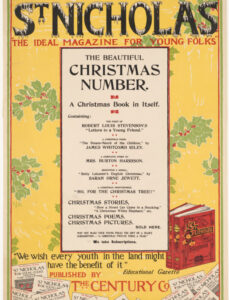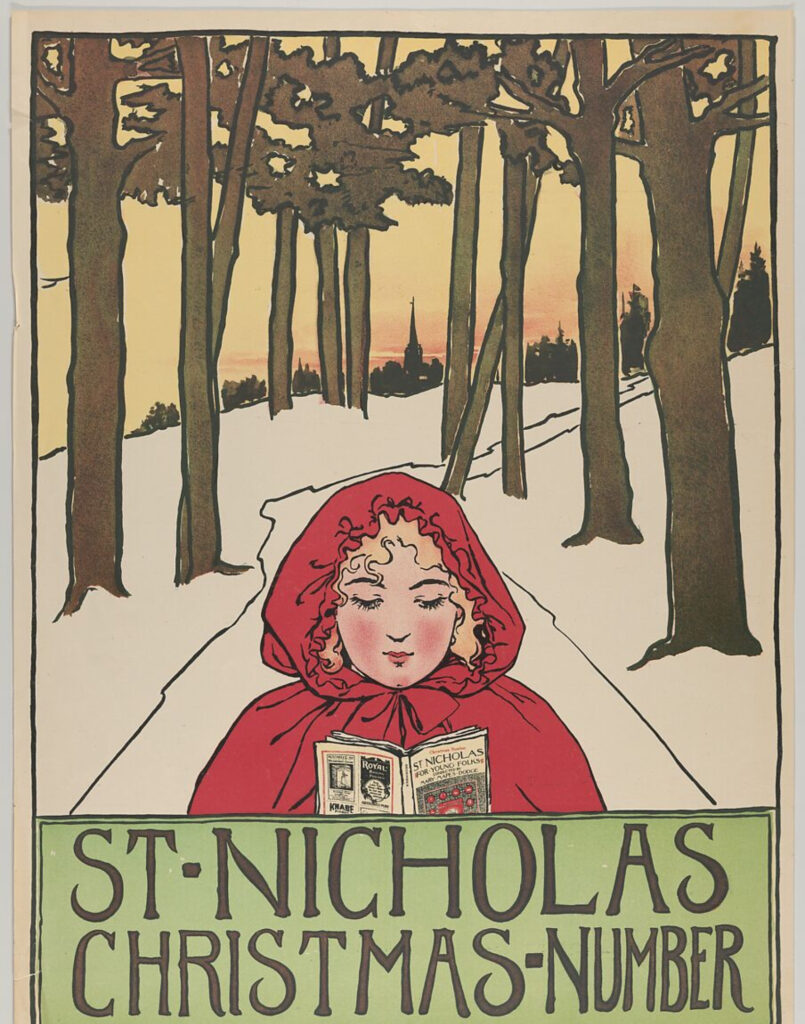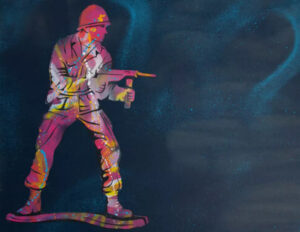
The Historical Context of St. Nicholas Magazine
St. Nicholas Magazine, founded in 1873 by Charles Scribner’s Sons and edited by Mary Mapes Dodge, was a revolutionary publication for children. Emerging during a period when childhood was being redefined in cultural and educational terms, the magazine catered to a growing demand for quality literature and art aimed specifically at young readers. It featured works by some of the most prominent authors of the time, including Louisa May Alcott, Mark Twain, and Rudyard Kipling.
The annual Christmas Number became a hallmark of the publication, representing a unique blend of entertainment, education, and celebration. These special editions were packed with festive stories, poems, and illustrations, capturing the magic of the holiday season and reflecting the cultural values of the late 19th and early 20th centuries. The accompanying lithographs were not mere decorative additions but integral components of this seasonal celebration.
The Artistic Significance of the Lithographs
The St. Nicholas Christmas Number lithographs are notable for their exceptional craftsmanship and artistic quality. Lithography, a relatively new technique at the time, allowed artists to create detailed, multicolored prints that were both visually stunning and accessible to a wider audience. These lithographs often depicted idyllic holiday scenes featuring snow-covered landscapes, joyous children, and traditional Christmas symbols like holly, mistletoe, and St. Nicholas himself.
One recurring motif was the figure of St. Nicholas, often portrayed in a manner that bridged European traditions and emerging American interpretations of Santa Claus. These depictions were heavily influenced by the works of artists like Thomas Nast, whose illustrations in Harper’s Weekly shaped the modern image of Santa Claus. The St. Nicholas Christmas Number lithographs contributed to this evolving iconography, blending old-world charm with a burgeoning sense of American cultural identity.
The Artists Behind the Magic
While many of the artists who contributed to the St. Nicholas Christmas Number lithographs remain anonymous, the periodical regularly collaborated with some of the most talented illustrators of the time. Among them were Howard Pyle, known as the father of American illustration, and Jessie Willcox Smith, celebrated for her enchanting depictions of children and domestic life.
Pyle’s influence is evident in the lithographs’ narrative quality, with each image telling a story that resonates with the viewer. His ability to capture the innocence and wonder of childhood made his work a natural fit for St. Nicholas Magazine. Similarly, Smith’s delicate use of color and composition lent a sense of warmth and intimacy to the holiday scenes, making them both relatable and aspirational.
Historicism in the Lithographs
The St. Nicholas Christmas Number lithographs are steeped in historicism, reflecting both the cultural traditions of their time and the broader historical context of Christmas celebrations. The imagery often draws on European holiday customs, such as the figure of St. Nicholas, the use of evergreen decorations, and the depiction of festive feasts. At the same time, these lithographs incorporate elements of American innovation, such as the modernized Santa Claus and the emphasis on family-oriented celebrations.
This blend of tradition and modernity mirrors the broader cultural currents of the late 19th century, a period marked by industrialization, urbanization, and the rise of consumer culture. The lithographs not only celebrate the timeless values of generosity and joy but also reflect the era’s fascination with progress and innovation.
The Resurgence of Interest in the 21st Century
In recent years, St. Nicholas Christmas Number lithographs have experienced a resurgence in popularity, driven by a growing trend toward nostalgia and vintage aesthetics. Collectors, artists, and designers are increasingly drawn to these works for their historical significance, artistic quality, and timeless appeal.
This renewed interest is part of a broader cultural movement that values authenticity and connection to the past. In a world dominated by digital media, the tangible beauty of lithographs and the stories they tell offer a refreshing counterpoint. The intricate details, rich colors, and evocative imagery of the St. Nicholas Christmas Number lithographs resonate with modern audiences, serving as both decorative art and a portal to a bygone era.
Contemporary Influence on Art and Design
The influence of the St. Nicholas Christmas Number lithographs extends beyond collectors to contemporary artists and designers. The festive imagery and nostalgic themes have inspired a new wave of holiday-themed artwork, ranging from greeting cards and wrapping paper to digital illustrations and home decor.
Modern artists often reinterpret these vintage lithographs, blending traditional motifs with contemporary aesthetics. This fusion creates a sense of continuity, connecting the past with the present and ensuring that the legacy of the St. Nicholas Christmas Number lives on.
Preservation and Accessibility
As interest in St. Nicholas Christmas Number lithographs grows, efforts to preserve and share these works have become increasingly important. Many of these prints are fragile, having been produced on delicate paper over a century ago. Archivists, collectors, and institutions are working to digitize and restore these lithographs, making them accessible to a wider audience while ensuring their preservation for future generations.
- Digital platforms and online marketplaces have also played a significant role in bringing these lithographs to the attention of new audiences. Collectors can now find rare editions with relative ease, while enthusiasts can explore the rich history and artistry of St. Nicholas Magazine through online archives and exhibitions.
Impression
The St. Nicholas Christmas Number lithographs are more than just beautiful works of art—they are windows into the past, capturing the spirit of Christmas and the cultural values of their time. Through their intricate designs, historic themes, and artistic excellence, these lithographs continue to inspire and delight audiences over a century after their creation.
As trends in nostalgia-driven art and holiday collectibles grow, the St. Nicholas Christmas Number lithographs remain a shining example of the enduring power of tradition and creativity. Whether displayed as cherished keepsakes, studied as historical artifacts, or reimagined in contemporary art, these works remind us of the magic and meaning of the holiday season.
No comments yet.








